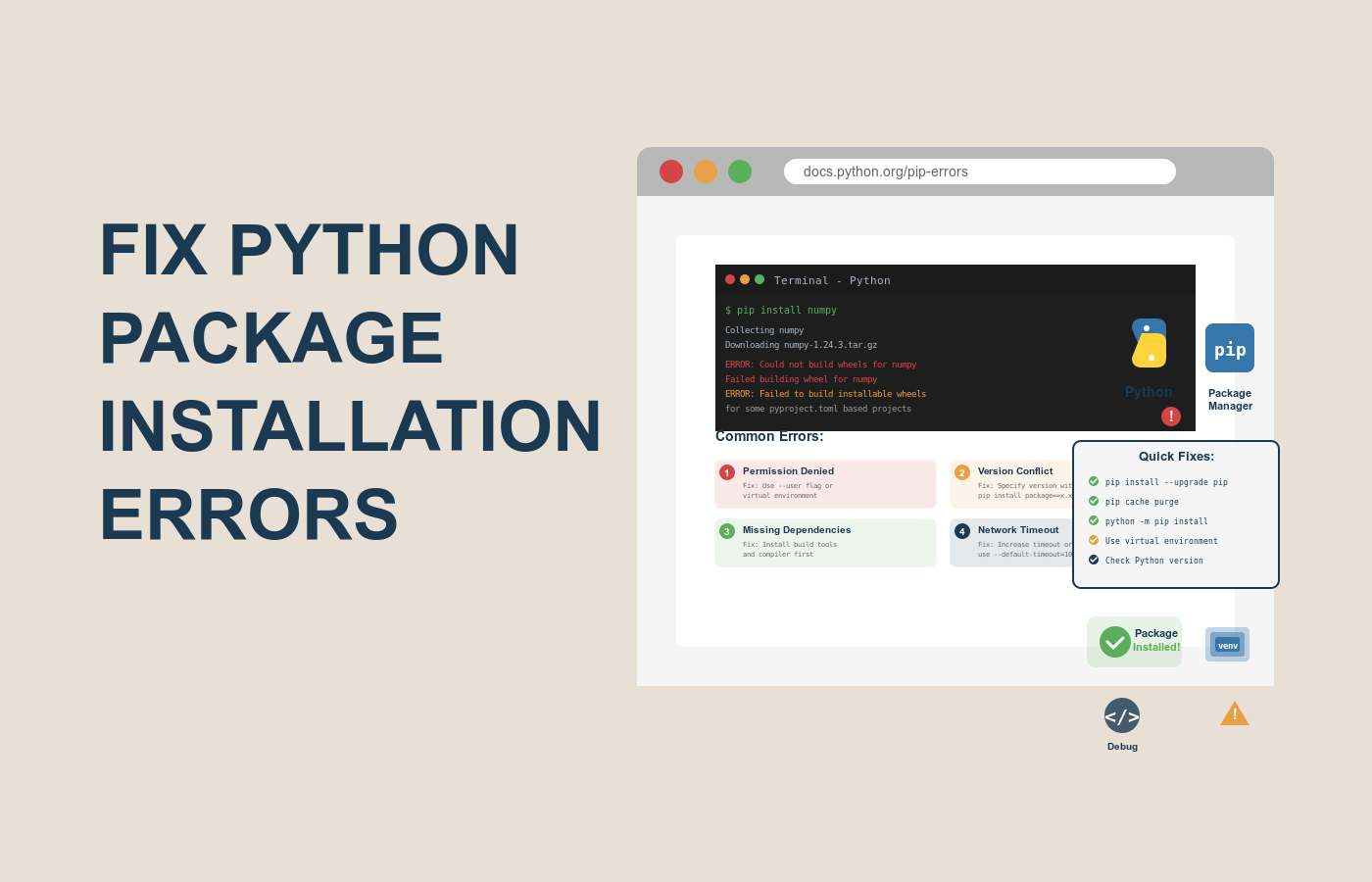How to Fix Python Package Installation Errors
Why Python Package Installation Errors Matter
Python is one of the most powerful and widely used programming languages today. From web development to AI and data science, it powers millions of projects. However, one of the most frustrating challenges developers face — especially beginners — is Python package installation errors.
Whether you’re trying to install a library like pandas, numpy, or tensorflow, you’ve probably encountered messages like:
ERROR: Failed building wheel for numpy
or
ModuleNotFoundError: No module named 'xyz'
These errors can stop your workflow instantly and make debugging a nightmare. The good news? Almost every Python installation error has a clear reason and a simple fix — once you understand what’s going wrong.
In this guide, we’ll walk through the most common causes of Python installation errors, explain step-by-step fixes, and share practical tips to prevent these issues from happening again.
Common Causes of Python Package Installation Errors
Before we dive into fixes, it’s important to understand why Python throws installation errors. Here are the top reasons:
1. Missing or Outdated pip
-
pipis Python’s package manager. -
If it’s not installed or outdated, Python won’t be able to fetch and install packages from PyPI.
2. Incorrect Python Version
-
Some packages support only certain versions of Python.
-
For example, a library might support Python 3.8+ but not 3.6.
3. Dependency Conflicts
-
When two packages require different versions of the same dependency, pip can’t resolve it properly.
4. Missing Build Tools
-
Packages with C/C++ extensions (like
lxml,pandas,cryptography) need compiler tools. -
On Windows, you may need Microsoft Build Tools or Visual Studio components.
5. Virtual Environment Issues
-
Installing packages globally instead of within a virtual environment can cause permission or path errors.
6. Network or SSL Errors
-
Sometimes pip can’t connect to PyPI due to firewalls, SSL certificate issues, or proxy settings.
7. Incorrect Command or Typo
-
A simple typo like
pip instal numpyinstead ofpip install numpycan cause unnecessary frustration.
Step-by-Step Guide to Fix Python Package Installation Errors
Let’s go through the most effective fixes — starting with the easiest and most common.
1. Check Your Python and Pip Installation
First, verify if both Python and pip are installed correctly.
Run these commands in your terminal:
python --version
pip --version
If you get errors like “pip not recognized,” it means pip isn’t installed or your PATH variable isn’t set properly.
Fix:
To install or upgrade pip:
python -m ensurepip --upgrade
python -m pip install --upgrade pip
Pro Tip: Always upgrade pip before installing any major library:
pip install --upgrade setuptools wheel
2. Use a Virtual Environment
Using a virtual environment isolates your projects and prevents version conflicts.
Steps:
python -m venv venv
source venv/bin/activate # For macOS/Linux
venv\Scripts\activate # For Windows
Now, install your package:
pip install package_name
You’ll notice far fewer errors when working inside virtual environments.
3. Fix “Failed Building Wheel” Errors
This is a common issue when installing libraries like lxml, cryptography, or mysqlclient.
Cause:
These libraries need to compile source code using system tools.
Fixes:
-
Windows:
Install Visual C++ Build Tools:
https://visualstudio.microsoft.com/visual-cpp-build-tools/ -
macOS:
Run:xcode-select --install -
Linux:
Run:sudo apt update sudo apt install build-essential python3-dev
Once installed, try reinstalling the package:
pip install <package-name>
4. Fix “Module Not Found” Errors
If Python says ModuleNotFoundError, it means the package wasn’t installed correctly — or you’re using the wrong environment.
Fix:
Check your Python version in your IDE or script:
import sys
print(sys.executable)
Then, ensure pip installs packages in the same environment:
/path/to/python -m pip install package_name
Tip:
Use which python or where python to confirm your environment path.
5. Fix SSL or Connection Errors
Sometimes, network restrictions prevent pip from connecting to PyPI.
Solutions:
-
Upgrade pip’s CA certificates:
pip install --upgrade certifi -
If you’re behind a proxy:
pip install package_name --proxy http://username:password@proxyserver:port -
Try using a different index:
pip install package_name -i https://pypi.org/simple
6. Fix Dependency Conflicts
When you see messages like:
ERROR: Cannot install packageA and packageB because of conflicting dependencies
Fix:
Use the --use-deprecated=legacy-resolver flag:
pip install package_name --use-deprecated=legacy-resolver
Or use pip-tools for better dependency management:
pip install pip-tools
pip-compile
pip-sync
7. Reinstall a Fresh Python Version
If nothing works, your Python installation might be corrupted.
Steps:
-
Uninstall Python completely.
-
Download the latest version from https://www.python.org/downloads/.
-
Check “Add Python to PATH” during installation.
-
Reinstall your packages.
Pro Tip: Use Anaconda if you frequently manage data science or ML packages — it comes with preinstalled dependencies.
Comparison Table: Common Errors vs Fixes
| Error Type | Cause | Fix |
|---|---|---|
| pip not recognized | pip not in PATH | Install pip and add it to environment variables |
| Failed building wheel | Missing compilers | Install C++ build tools |
| Module not found | Wrong environment | Activate virtual env |
| SSL error | Network restriction | Upgrade certifi or use proxy |
| Dependency conflict | Version mismatch | Use pip-tools or legacy resolver |
Related Resource:
Now, let’s move into advanced troubleshooting, alternative installation methods, and real-world developer tips that can save you hours of debugging time.
Advanced Troubleshooting Methods
Sometimes, even after trying all basic solutions, installation errors persist. In such cases, deeper inspection is required.
Here are advanced-level fixes that professionals use when nothing else works
1. Use --no-cache-dir to Avoid Corrupt Caches
Pip stores cached versions of downloaded packages. If a previous download was incomplete or corrupted, it might keep reinstalling the broken copy.
Fix:
pip install --no-cache-dir package_name
This forces pip to re-download the package fresh from PyPI.
2. Use Precompiled Wheel Files
Some Python packages fail to install because they try to build from source, which needs compiler tools.
In such cases, downloading a wheel (.whl) file directly from https://www.lfd.uci.edu/~gohlke/pythonlibs/ is a smart alternative.
Steps:
-
Visit the above link.
-
Download the correct
.whlfile matching your Python version (e.g., cp311 for Python 3.11). -
Navigate to the folder in your terminal and run:
pip install package_name-version-cp311-cp311-win_amd64.whl
This method is particularly useful for Windows users installing packages like numpy, scipy, or opencv-python.
3. Rebuild Pip’s Internal Configuration
Sometimes pip’s internal configuration files can get corrupted.
To reset everything, run the following:
pip config list
pip config unset global.index-url
pip cache purge
Then reinstall your package:
pip install package_name
4. Use Conda Instead of Pip (for Complex Packages)
If you work with heavy data science or AI libraries like tensorflow, pytorch, or opencv, consider using Anaconda or Miniconda instead of pip.
Why Conda Helps:
-
It handles binary dependencies automatically.
-
It avoids compiler errors.
-
It’s more stable for cross-platform installations.
Example:
conda install numpy
conda install tensorflow
You can also create separate conda environments for each project:
conda create --name myenv python=3.11
conda activate myenv
5. Upgrade or Reinstall Setuptools and Wheel
When you see messages like:
ERROR: legacy-install-failure
it often means your packaging tools are outdated.
Fix:
pip install --upgrade setuptools wheel
These two tools are essential for building and installing Python libraries.
6. Verify Package Compatibility
Before installing any library, it’s a good idea to check its compatibility with your Python version.
You can use:
pip index versions package_name
This will show all available versions of the package and their supported Python versions.
✅ Example:
If pandas 2.2.0 doesn’t support Python 3.7, install a compatible version:
pip install pandas==1.3.5
Best Practices to Prevent Future Errors
Fixing errors is good, but avoiding them altogether is better. Here are a few habits to adopt to keep your Python setup healthy and error-free:
1. Always Work in Virtual Environments
Each project should have its own environment:
python -m venv env
source env/bin/activate
This avoids version conflicts between different projects.
2. Keep Pip and Python Updated
Every few weeks, run:
python -m pip install --upgrade pip setuptools wheel
And keep your Python version modern (preferably 3.10+).
3. Use requirements.txt
Save all your dependencies:
pip freeze > requirements.txt
Then you can easily reinstall them later:
pip install -r requirements.txt
4. Avoid Mixing Global and Local Installs
Never use sudo pip install. It can break your global system packages.
Instead, use environments or user installs:
pip install --user package_name
5. Check Documentation Before Installing
Always verify the library’s official docs for supported versions and dependencies.
For example, https://pypi.org/ lists all packages with their compatibility info.
Comparison: pip vs conda for Installation
| Feature | pip | conda |
|---|---|---|
| Package Source | Python-only (PyPI) | Multi-language (Python, R, C, etc.) |
| Handles Dependencies | Limited | Excellent |
| Ease of Use | Simple | Slightly complex |
| Ideal For | Small projects, web dev | Data science, ML, complex dependencies |
| Platform | Cross-platform | Cross-platform |
| Example Command | pip install flask |
conda install flask |
Extra Tips & Workarounds
Here are some additional insights for those who often work with Python environments:
-
Use Pyenv to manage multiple Python versions easily:
https://github.com/pyenv/pyenv -
Use Poetry as an advanced dependency manager:
It simplifies packaging, dependency resolution, and virtual environments.
Install with:pip install poetry -
Use Docker for isolated environments:
If you deploy applications, containerization helps you avoid “it works on my machine” errors. -
Read StackOverflow Threads:
Most installation errors have been solved by other developers. Searching the error message often gives instant answers.
FAQs About Python Package Installation Errors
1. Why am I getting “Failed building wheel” error in pip?
Because your system lacks required build tools or compilers.
Install Visual C++ Build Tools (Windows) or build-essential (Linux).
2. How can I fix pip not recognized in Windows?
Add pip to your PATH or reinstall Python with the “Add Python to PATH” option checked.
3. Why does pip install hang or freeze?
This usually happens due to a slow connection or SSL verification issue.
Use --default-timeout=100 or --no-cache-dir to fix it.
4. Should I use pip or conda for installing packages?
Use pip for lightweight, web-related libraries.
Use conda for data science and AI libraries that have complex dependencies.
5. How do I completely reset pip?
Run:
pip cache purge
pip uninstall pip
python -m ensurepip
This reinstalls pip from scratch.
Conclusion: Mastering Python Installation Errors
Python is powerful — but it demands a bit of setup discipline. Most package installation errors happen due to outdated tools, missing compilers, or dependency conflicts.
Here’s a quick recap:
-
Always update pip and setuptools
-
Use virtual environments for every project
-
Install system build tools (especially on Windows)
-
Fix SSL or network-related pip errors
-
Use conda or wheel files for complex libraries
By applying these practices, you’ll save time, avoid repetitive errors, and create a smoother development experience.
Related Resources
#PythonDevelopment #PipErrors #FixPythonInstallation #PythonBeginners #CondaVsPip #PythonTroubleshooting #CodingTips


